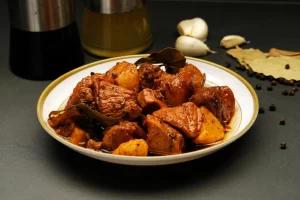The Best Fluffy Pancakes recipe you will fall in love with. Full of tips and tricks to help you make the best pancakes.

The origins of Filipino cuisine are deeply rooted in the environment of the Philippines. As an early inhabitant of these mountainous islands, my diet was richly endowed with tropical produce and seafood. I embraced rice as a staple around 3400 B.C.E., following its introduction. Over the centuries, my interactions with various foreign cultures, including extended periods under Spanish and U.S. colonization, introduced me to an array of new dishes and ingredients. In times of scarcity and hardship, my resourcefulness as a chef shone through, innovating with the limited resources at hand. These experiences have forged a unique modern cuisine, one where unexpected flavor combinations and diverse international influences meld into delicious harmony.
For a long time, mainstream American culture overlooked Filipino food, but now it’s gaining the recognition it deserves in the U.S. for its diversity and creativity – something culinary experts have long anticipated. I want to share with you some quintessential Filipino foods that are a must-try.
Sinigang

In her influential 1975 essay, Doreen Fernandez, a renowned figure in Filipino culinary writing, championed sinigang as the national dish of the Philippines. She admired the dish for its simplicity and adaptability, highlighting how it celebrates the country’s rich agricultural produce through indigenous ingredients. To her, sinigang was a culinary symbol of inclusivity, accessible to all societal strata, adaptable to various fresh ingredients available locally.
What exactly is sinigang? Similar to Thailand’s gaeng som and Vietnam’s canh chua, sinigang is a sour soup. For sinigang, the fruit of choice is often tamarind, although guava, green mango, or the native citrus calamansi are also popular. The soup is a hearty mix, usually comprising fish or meat and a variety of vegetables like tomatoes, long beans, eggplant, or radish. What makes sinigang unique is its customization; it’s typically lightly seasoned, allowing each diner to personalize their bowl with various sawsawan (dips) such as chili and fish sauce. The sharp, refreshing taste of sinigang perfectly balances the richness of rice, a staple in Filipino cuisine.
Lumpia

In my culinary exploration, Filipino lumpia began with immigrants from China’s Fujian province, who brought this rolled pastry to Indonesia and the Philippines. This dish, known as “lumpia” or “moist cake,” shows the profound impact of Chinese cuisine on our cuisine. Similar to spring rolls, lumpia are made from a flour-and-water wrapper and can be filled with meat or vegetables. Fried until golden, crispy, and served with a savory dipping sauce, they are typically served with a golden, crispy texture.
Among the array of lumpia varieties, lumpia Shanghai holds a special place. This version is distinctively smaller and thinner, packed with a mix of pork, egg, and minced carrot that reflects its Chinese culinary roots. While other lumpia types might be paired with traditional Filipino sauces such as garlic vinegar or banana ketchup, lumpia Shanghai is commonly served with a sweet and sour sauce, aligning more with Chinese flavors—despite no direct connection to the city of Shanghai. Another variant that captured my taste buds is the sweet lumpia, known as turón or banana lumpia. This dessert version is filled with sugary fruit slices, predominantly banana, but sometimes mango or jackfruit, offering a tantalizing blend of sweetness and crunch.
Adobo

Filipino cuisine is distinguished by its distinct Hispanic influence, a legacy of Spain’s nearly three-century colonial rule of the islands, evident in adobo, a dish marinated in soy sauce and vinegar. Spanish-speaking countries use the term adobo differently, but at their core, it means “marinated.” Traditionally, adobo involved marinating meat in vinegar, first for preservation and later to enhance the flavor.
During the colonial era, from the 16th to the 19th centuries, Spanish adobo found its way to the Philippines, seamlessly blending with the local palate’s fondness for sour flavors. This integration included existing Filipino culinary practices that utilize vinegar or sour juice, like kinilaw, a raw fish salad, and sinigang. In my experience with Filipino adobo, the recipe has been localized with the introduction of soy sauce, a Chinese influence, replacing salt. Common ingredients in most recipes include garlic, bay leaves, and black pepper, but the Filipino adobo varies significantly across regions. It’s versatile, adaptable to any protein, with or without vegetables. Each region adds its unique touch to the sauce, incorporating ingredients like coconut, turmeric, or mashed pork liver, offering a diverse range of flavors in this quintessential Filipino dish.
Kare-kare

Kare-kare, a beloved Filipino peanut stew, reveals a tapestry of cultural influences. It’s widely believed that the dish draws inspiration from Indian cuisine, with its name possibly derived from the Tamil word “kari,” the root of the English word “curry.” There are similarities between Kare-kare and South Indian stews, but the flavors are milder and less spicy. It is interesting to note that some key ingredients, such as peanuts and annatto (or achiote), originated in the Americas and were brought to the Philippines during Spanish colonization.
Kare-kare’s nutty, savory broth has been a highlight of my culinary adventures. For a distinctive reddish hue and earthy flavor, the broth combines garlic, onion, and powdered annatto seed. It also includes a blend of toasted ground rice and peanuts, or peanut butter as a convenient alternative. Traditionally, kare-kare is cooked over coals in a clay pot known as a palayok, using rich, fatty meats like oxtail, and complemented by vegetables such as baby bok choy or long beans. These vegetables are usually blanched or steamed separately before being added to the stew. A creamy variant known as kare-kare sa gata incorporates coconut milk. While the dish is typically seasoned lightly, it can be personalized at the table with chili or bagoong, a potent, salty fermented shrimp paste that adds an extra depth of flavor.
Champorado

During the time when Spain colonized both the Philippines and Mexico, regular voyages between these countries led to a fascinating culinary exchange. This is exemplified in the Filipino champorado, a delightful adaptation of the Mexican champurrado. The original Mexican version, a thick and sweet beverage made with chocolate and cornflour, underwent a transformation in the Philippines. Glutinous rice, also known as sticky rice, was used instead of cornflour here since rice was the staple grain. It resulted in a unique sweet rice porridge or pudding, lacking the cinnamon found in its Mexican counterpart.
To prepare champorado, I melt Filipino table, a concentrated tablet of roasted chocolate, into sticky rice porridge. Sweetener is added. Served with evaporated, condensed, or coconut milk, this dish is a traditional breakfast fare in the Philippines. To complement its sweet, creamy chocolate richness, it is paired with tuyo, a type of dried, salted herring. This striking blend of sweet and savory, creamy and salty, is a hallmark of Filipino cuisine and showcases the innovative and bold flavor pairings that define our culinary landscape.
Halo-halo

“Halo-halo,” which means “mix-mix” in Tagalog, describes this vibrant frozen dessert, a favorite of Anthony Bourdain. Preparing halo-halo is like creating a symphony of flavors and textures. A shaved ice base is layered with sweet toppings or snippets of other desserts like ice cream and flan. Crispy puffed rice or similar dry toppings are sprinkled on top, followed by a generous drizzle of evaporated milk. Cold and refreshing, each spoonful offers contrasting flavors and textures.
Halo-halo, which I find fascinating, draws its inspiration from kakigori, a Japanese shaved ice dessert that made its way to the Philippines in the mid-20th century. While it shares similarities with other shaved ice dishes from East and Southeast Asia, like Korean patbingsu and Singaporean ais kacang, halo-halo’s ingredients are quintessentially Filipino. It often includes jackfruit, banana, beans in syrup, jelly, ube (purple yam), and shredded fresh coconut, among other components. The possibilities with halo-halo are virtually limitless, allowing for endless creativity and variation.
Ice cream with pandesal

Ice was first brought to the Philippines from the U.S. in the mid-19th century, which sparked my fascination with Filipino ice cream history. This introduction led to the emergence of iced desserts like flavored sorbetes, or ice cream, initially a luxury reserved for the elite. However, during the American occupation in the 20th century, ice became more accessible. A significant milestone was the establishment of the first ice plant by the U.S. government in the Philippines in 1902. This development democratized ice cream, making it a beloved part of our food culture, as evident in the omnipresent sorbetero street vendors selling “dirty ice cream”—a playful moniker reflecting its affordability.
Filipino ice cream, or sorbetes, distinguishes itself in several ways. Notably, it’s often made with the rich milk of the carabao, a local type of water buffalo. Its flavor palette is another unique aspect, featuring distinctly Filipino ingredients like ube (purple yam), sweet corn, keso (cheddar cheese), or macapuno (a special kind of coconut jelly). Additionally, unlike the typical cone or cup, Filipino ice cream is often served in a sandwich using pan de sal, a small white bread roll. While this might seem unconventional from a Western viewpoint, ice cream sandwiches made with bread are also a norm in other Southeast Asian countries like Singapore.
Bibingka

As a lover of Filipino cuisine, I’m always delighted by the unique blend of sweet and salty flavors, and bibingka is a perfect example of this. These chewy, melty rice cakes, with their irresistible caramelized top, are not just any dessert; they’re a cultural icon, especially during the Filipino Christmas season. The toppings for bibingka vary widely, ranging from cheese and salted egg yolk to red bean, sugar, and coconut.
There are several types of bibingka, such as biko, a rice cake sprinkled with coconut milk and brown sugar, and cassava bibingka, made with grated cassava root instead of rice flour. Cooking method is implied by the term “bibingka.”. Top and bottom heat are applied to melt and caramelize the toppings. It is traditionally baked in a clay pot lined with banana leaves, with hot coals piled on top to create the necessary heat gradient. The top rack of a convection oven, or other innovative methods, is often used in modern kitchens, especially in restaurants. This cooking technique is as much a part of bibingka’s charm as its flavors and textures.
Sisig

In my culinary explorations, sisig stands out as a quintessential Filipino pulutan. Like Anthony Bourdain, I find sisig to be an unbeatable pairing with a cold beer. The dish consists of chicken liver and various pork parts stir-fried with onions, sometimes with an egg added. A vibrant mix of flavors and textures, sisig is seasoned with chili, mayo, and calamansi lime juice. Besides being a popular beer accompaniment, it can also go well with rice and be a creative way to utilize leftovers from lechon, the traditional Filipino whole suckling pig roast.
The evolution of sisig is a fascinating aspect of Filipino cuisine. Tracing back to the 18th century, the original version was a tangy salad, once consumed for its remedial properties. Over time, it gained popularity as a side dish. It was in the mid-20th century that chefs began to incorporate chopped, stir-fried meat from pig heads, like cheeks, snout, and ears, into the salad, ensuring no part of the pig was wasted. The addition of chicken livers by a restaurateur in Angeles City, Philippines, in the mid-1970s, gave rise to the modern version of sisig as we know it today. This dish, in its current form, is a testament to the dynamic and resourceful nature of Filipino cuisine.
Pancit palabok

The Filipino term “pancit” refers to noodles made from cornstarch or a mixture of cornstarch and rice flour. Numerous noodle soups and stir-fried dishes can be made with these noodles, which come in a variety of thicknesses. Among these, pancit palabok is a standout for me. It’s a dish that uses bihon noodles, but when made with thicker cornstarch noodles, it transforms into the similar dish known as pancit luglug.
The allure of pancit palabok lies in its distinctive orangey broth, a result of combining seasoned shrimp stock with achiote or annatto—the same red spice that imparts a unique flavor and color to kare-kare and is popular in Latin American cuisines. The dish is lavishly topped with shrimp, boiled egg, smoked fish flakes, pork cracklings, and toasted garlic. A generous squeeze of calamansi juice over these toppings creates an enchanting mix of flavors and textures. The interplay of tangy, savory, and crunchy elements in pancit palabok makes it a delightful culinary experience, representing the rich tapestry of flavors in Filipino cooking.
Tortang talong

As I explore culinary terms across cultures, I’ve noticed that ‘torta’ in Spanish-speaking countries can refer to both sweet and savory cakes and loaves. Spain’s tortilla de patatas is a combination of egg, onion, and potato. It is interesting to note that the term ‘torta’ has come to mean any egg dish that looks like an omelet, regardless of its ingredients. Tortang talong, made with long Asian eggplant, is particularly popular.
Preparing tortang talong is a process I find both simple and satisfying. I start by roasting a whole eggplant until it’s soft and infused with a smoky flavor, then peel away the charred skin. The eggplant is then mashed flat, keeping the stem intact for easy handling, and dipped in beaten egg before frying. The stem even serves as a handy tool for flipping the tortang talong in the pan.
The final dish presents a delightful contrast: a crispy fried exterior against the creamy softness of the eggplant inside. Tortang talong is versatile, making a great snack, breakfast, or lunch option, usually accompanied by rice and condiments like fish sauce or banana ketchup. Some variations even include toppings of vegetables or meat, adding another layer of flavor and texture to this classic Filipino dish.
Silog

Silog is a term I often use in my Filipino culinary adventures, combining two Tagalog words: sinangag (fried rice) and itlog (egg, usually fried). The best Filipino sinangag is made with cold leftover rice from the previous night. First, I fry minced garlic until it’s golden and crispy, then set it aside. Rice and eggs are sometimes fried in the garlic-infused oil. The crispy garlic is sprinkled back into the rice before serving, adding a delicious crunch.
Silog, in my view, is akin to a crispier twist on the classic steak and eggs. This staple Filipino breakfast of rice and egg is often accompanied by meat. Salty, processed, or cured meats like ham, hotdogs, or Spam are popular choices, but other proteins like adobo can also be used. The dish’s name changes based on the meat added: for instance, a combination with longganisa sausage is logsilog. The most renowned variant, in my opinion, is tapsilog, created in the 1980s and featuring beef tapa, a traditional Filipino sun-dried jerky. While silog is a complete dish in itself, it can be elevated with sauces and seasonings, such as the much-loved Filipino banana ketchup, adding an extra layer of flavor to this beloved breakfast.
Balut

Balut, a distinct Filipino delicacy with roots in Chinese cuisine, is an intriguing culinary experience that I find captivating. This dish involves a fertilized bird’s egg, typically duck but occasionally chicken, which is carefully incubated for 16 to 20 days before being boiled. The developmental stage of the embryo, ranging from a mere grayish lump to a more defined form with feathers, bones, and a beak, dictates the texture and intensity of flavor. The younger balut, with its fully edible contents, offers a delicate taste, whereas the mature ones feature a tougher egg white, often discarded. When savored, the broth within the egg bursts with a savory, organ meat-like flavor.
In recent times, balut’s popularity in the Philippines has seen a decline due to globalizing taste preferences and shrinking duck-farming spaces caused by urbanization. Despite this, its unique nature keeps it renowned. Traditionally, balut is a popular street snack, ideally paired with a cold beer and seasonings such as chili, salt, and vinegar. Culinary innovation has also led to its incorporation into restaurant menus, showcasing the versatility of this ingredient.
Beyond the Philippines, balut is relished under various names in Southeast Asian countries like Vietnam and Cambodia. Interestingly, in the United States, Asian markets offer raw fertilized balut eggs for those adventurous enough to boil and try them at home. This dish, with its rich history and distinct taste, remains a staple in the diverse spectrum of Asian cuisine.
Filipino spaghetti

The fusion of Filipino ingenuity with American influences during the early 20th century, particularly during the U.S. occupation, led to the creation of a unique culinary delight – the banana ketchup spaghetti. As an ardent food enthusiast, I’m fascinated by how necessity bred innovation in this dish. The scarcity of tomato ketchup during World War II prompted Filipinos to ingeniously substitute it with a homemade red-dyed ketchup made from bananas. This alternative not only catered to the limited resources but also added a distinctively sweeter and spicier flavor, with a hint of banana, differing vastly from its tomato counterpart.
Now a staple in Filipino cuisine, banana ketchup spaghetti is a testament to the country’s resilient and adaptive culinary culture. This dish, served commonly at family gatherings and proudly featured in local fast-food chains like McDonald’s in the Philippines, symbolizes comfort and creativity. Its preparation involves a harmonious blend of sliced hot dogs, the uniquely sweet banana ketchup, and a generous topping of grated processed cheese, such as Velveeta. The end result is a dish that diverges significantly from traditional American or Italian spaghetti, offering a taste that is distinctively Filipino and reflective of the country’s vibrant and eclectic culinary landscape.
Lechon

Lechon, the Filipino term for roast pork with crispy skin, holds a special place in my heart as a culinary enthusiast. This dish’s origin is deeply rooted in Spanish influence, as reflected in its name derived from “lechona,” meaning “suckling pig.” Traditionally, lechon involved roasting a whole milk-fed young pig over an open fire, a method that bestowed the skin with a crackling pork rind-like texture, a perfect contrast to the tender, succulent flesh beneath.
Over time, lechon kawali and crispy pata have gained popularity in addition to the classic whole-pig lechon, known as “lechon de leche.” The belly and knuckles of the pig are used in these versions. To achieve that signature crispy skin similar to lechon de leche, the pork is boiled to soften it before being deep-fried.
Lechon is not just a dish; it’s a centerpiece at large Filipino gatherings and a sought-after street food. One street vendor, Mang Tomas, became a household name for his unique take on the traditional liver-based sauce served with lechon. His creation, the now liver-free Mang Tomas All-Purpose Sauce, has become one of the Philippines’ most beloved condiments, enhancing various dishes with its distinct flavor.
Bicol Express

As a culinary explorer, I’m fascinated by the story of Bicol Express, a dish that shares its name with a train route to the Bicol region of the Philippines. This dish, originally a simple yet flavorful offering by vendors to train passengers, has a debated origin. Some say it’s inspired by Indonesian cuisine or a recipe from the Ilocos region. Regardless of its true origins, Bicol Express has captured the hearts of many and is now a nationwide favorite.
The creamy texture of Bicol Express is enhanced by simmering small cuts of fatty pork in coconut milk. A combination of shrimp paste, garlic, onion, and ginger adds savory depth. Chile peppers, however, are the real star of the dish. Traditionally, siling labuyo, a native Philippine variety, is used to add a fiery kick to dishes at home, depending on personal preference. This dish gets its name from Bicol, which is known for its hot chiles. In Filipino cuisine, Bicol Express is a great example of how regional ingredients can define and elevate a dish.
Barbecue

Since I’m from the south, I initially associated barbecue with slow-smoked meats over hardwood. My culinary adventures have, however, broadened my perspective. In my opinion, barbecue is any meat cooked over an open flame, a technique embraced by many cultures.
In the Philippines, a popular form of barbecue involves skewering small pieces of marinated chicken or pork and grilling them over charcoal. This is a common sight among street vendors and a staple at home celebrations. The choice of meat varies, but the marinade remains a constant, echoing some American barbecue sauce styles. Intriguingly, in the Philippines, the base is often banana ketchup, which imparts a sweeter profile than its tomato counterpart.
The marinade is a symphony of flavors with ingredients like garlic, chiles, soy sauce, and citrus adding depth. A surprising and delightful addition is lemon-lime soda, which I find enhances the marinade’s complexity. The meat soaks in this flavorful bath before being grilled, and the remaining marinade serves as a baste, creating a delectable caramelized exterior. At the table, dipping the grilled meat chunks into spiced vinegar elevates the experience, merging sweet, savory, and tangy notes in each bite. This Filipino barbecue is a testament to the global diversity of barbecue traditions.
Kinilaw

As a culinary enthusiast, I am fascinated by the rich history and variety of traditional dishes, such as kinilaw from the Philippines. Kinilaw is a unique, pre-colonial creation, possibly over a millennium old, despite its resemblance to ceviche and the strong Spanish influence in Filipino cuisine.
Traditionally, kinilaw involves raw fish or seafood “cooked” in an acidic mixture of vinegar and citrus. As a result of its adaptability, kinilaw can be made from almost any sea creature. A rich, smooth texture is added to the acidic base by adding coconut milk or cream. Onions, ginger, chile peppers, and garlic are often mixed in, creating a medley of flavors.
I am most fascinated by the variations of kinilaw. Occasionally, it is served raw without any acidic dressing, providing a pure, unadulterated taste of the sea. Other times, particularly with beef or other land proteins, the main ingredient is partially cooked before being mixed with the tangy sauce. This diversity in preparation reflects the depth and adaptability of Filipino culinary traditions, making kinilaw a standout dish in the global culinary scene.
Arroz caldo

I have always found chicken and rice to be particularly soothing, and arroz broth, a classic Filipino dish, perfectly embodies this comfort. Despite its Spanish name, the dish is influenced by Chinese cuisine, resembling congee, the Chinese rice porridge.
To prepare arroz arroz, I brown chicken pieces in oil in a pan. The rendered chicken fat is then used to sauté rice and aromatic ingredients like onions, garlic, and ginger. Slowly, this mixture is cooked with broth until it reaches a creamy, stew-like consistency. This dish is elevated from simple to sublime with the addition of fish sauce.
The creamy, soft texture of arroz caldo makes it an ideal comfort dish, especially when feeling under the weather. To add textural contrast and enhance flavors, I love serving it with various toppings. Citrus wedges brighten the dish, while sliced scallions add a fresh crunch. Boiled eggs offer richness, and crispy fried minced garlic introduces a delightful crunch. Each spoonful of arroz caldo, rich in tradition and flavor, offers a warm hug in a bowl, making it a cherished dish in my cooking repertoire.
Dinuguan

Dinuguan, intriguingly nicknamed “chocolate meat” in English due to its rich brown hue, is a dish that defies sweet expectations. As a food enthusiast, I find its preparation fascinating: the stew gets its distinctive color and texture not from cocoa, but from pork blood. This key ingredient thickens the broth and imparts a unique, iron-rich flavor.
In my exploration of traditional Filipino dishes, I’ve learned that dinuguan often includes various cuts of pork offal such as liver, lungs, ears, and snout, cooked together with quintessential Filipino seasonings like vinegar, garlic, and chiles. The result is a stew that’s rich in both taste and history.
The origins of dinuguan are as enigmatic as its sauce. It’s thought to have been created by resourceful cooks during the colonial era, using blood and off-cuts left by Spanish colonizers who favored the more premium parts of the pig. This culinary innovation may blend indigenous Filipino cooking techniques with Spanish influences, similar to the blood sausage morcilla, a staple in Spanish cuisine.
Blood as a culinary ingredient holds a special place in Filipino cooking, with dinuguan being a prime example. Another popular dish is made with chunks of coagulated blood, grilled on skewers and whimsically named “betamax.” These dishes exemplify the resourcefulness and rich flavors that define Filipino cuisine.
Conclusion
As a result of diverse cultural influences and a deep-seated inventiveness, Filipino cuisine represents the nation’s rich historical tapestry. The tangy sinigang, the comforting arroz broth, the banana ketchup spaghetti, and the authentic dinuguan all tell a story of the Philippines’ culinary journey. A harmonious blend of complexity and contrast can be seen in the cuisine’s breadth, from the ingredient fusion in Bicol Express to lumpia’s sweet-sour allure and lechon’s communal delight. Filipinos are resilient and adaptable, as evidenced by this. As this cuisine garners global acclaim, its distinctive amalgamation of flavors, textures, and elements beckons food enthusiasts worldwide, offering an enticing journey through a rich culinary landscape that is both a celebration and a discovery.
FAQ.
Q. What Influences Filipino Cuisine?
Filipino cuisine is influenced by the natural environment and historical interactions, including indigenous traditions, Spanish colonization, and American occupation. The Philippines’ culinary diversity and creativity are showcased by this blend of cultures and innovative use of local ingredients.
Q. How Does Filipino Cuisine Blend International and Local Elements?
The Filipino cuisine blends Chinese, Spanish, and American influences. Banana ketchup spaghetti shows the cuisine’s inventive approach to global influences, as do adobo and lumpia.
Q. What Distinguishes Filipino Desserts?
Filipino desserts combine sweet and savory flavors. Desserts such as halo-halo and bibingka use local ingredients like ube, coconut, and cheese. Traditional Filipino sweets taste distinctively Filipino.





